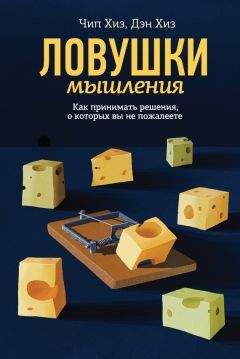Николас Эпли - Интуиция. Как понять, что чувствуют, думают и хотят другие люди
203
Briton, N. J., and J. A. Hall (1995). Beliefs about female and male nonverbal communication. Sex Rolex 32: 79–90.
204
Westfall, J., J. R. Chambers, and L. Van Boven (2012). False polarization among Americans (1970–2004): Partisan identification, attitude extremity, and civic action. Unpublished manuscript. University of Florida, Gainesville.
205
Rutchick, A. M., J. M. Smyth, and S. Konrath (2009). Seeing red (and blue): Effects of electoral college depictions on political group perception. Analyses of Social Issues and Public Policy 9: 269–282.
206
В США принято обозначать штаты, большинство избирателей в которых голосуют за республиканцев, красным цветом, а штаты, где большинство избирателей голосуют за демократов, – синим цветом.
207
Chambers, J. R., R. S. Baron, and M. L. Inman (2006). Misperceptions in intergroup conflict. Psychological Science 17: 38–45; Robinson, R. J., et al. (1995). Actual versus assumed differences in construal: “Naive realism” in intergroup perception and conflict. Journal of Personality and Social Psychology 68: 404–417; Farwell, L., and B. Weiner (2000). Bleeding hearts and the heartless: Popular perceptions of liberal and conservative ideologies. Personality and Social Psychology Bulletin 26: 845–852; Sherman, D. K., L. D. Nelson, and L. D. Ross (2003). Naive realism and affirmative action: Adversaries are more similar than they think. Basic and Applied Social Psychology 25: 275–289.
208
Fiorina, M. P., and S. J. Abrams (2008). Political polarization in the American public. Annual Review of Political Science II: 563–588; Seyle, D. C., and M. L. Newman (2006). A house divided? The psychology of red and blue America. American Psychologist 61: 571–580.
209
Epley N., E. M. Caruso, and M. H. Bazerman (2006). What perspective taking increase taking: Reactive egoism in social interaction. Journal of Personality and Social Psychology 91: 872–889.
210
Mallett, R. K., T. Wilson, and D. T. Gilbert (2008). Expect the unexpected: Failure to anticipate similarities leads to an intergroup forecasting error. Journal of Personality and Social Psychology 94: 265–277.
211
Masoro, E. J., and S. N. Austad (eds.) (2011). Handbook of the biology of aging. Burlington, MA: Academic Press.
212
Эти данные – показатели выполнения тестов из сборника Woodcock-Johnson Psychoeducational Test Battery в 1989 и 1990 годах. Приведенная в тексте книги цифра взята со с. 189 статьи: of T. A. Salthouse (1999). Pressing issues in cognitive aging. В книге: N. Schwarz, et al. (eds.), Cognition, aging, and self-reports (pp. 185–198). Levittown, PA: Psychology Press.
213
Levy, B., and E. Langer (1994). Aging free from negative stereotypes: Successful memory in China among the American deaf. Journal of Personality and Social Psychology 66: 989–997.
214
Levy, B. R., et al. (2009). Age stereotypes held earlier in life predict cardiovascular events in later life. Psychological Science 20: 296–298.
215
Levy, B. R., et al. (2002). Longevity increased by positive self-perceptions of aging. Journal of Personality and Social Psychology 83: 261–270.
216
Levy, B. R., et al. (2002). Longevity increased by positive self-perceptions of aging. Journal of Personality and Social Psychology 83: 1092–1107.
217
Steele, C. M., and J. Aronson (1995). Stereotype threat and the intellectual test performance of African Americans. Journal of Personality and Social Psychology 69: 797–811.
218
Inzlicht, M., and T. Schmader (2011). Stereotype threat: Theory, process, and application. New York: Oxford University Press. Also C. Steele (2010). Whistling Vivaldi. New York: W. W. Norton.
219
Cohen, G. L., et al. (2006). Reducing the racial achievement gap: A social-psychological intervention. Science 313: 1307–1310. Cohen, G. L., et al. (2009). Recursive processes in self-affirmation: Intervening to close the minority achievement gap. Science 324: 400–403; Walton, G., and G. L. Cohen (2011). A brief social-belonging intervention improves academic and health outcomes of minority students. Science 331: 1147–1151. Ramirez, G., and S. L. Beilock (2011). Writing about testing worries boosts exam performance in the classroom. Science 331: 211–213.
220
Ickes, W., P. R. Gesn, and T. Graham (2000). Gender differences in empathic accuracy: Differential ability or differential motivation? Personal Relationships 7: 95–109. См. также главу 6 книги: W. Ickes (2003). Everyday mind reading: Understanding what other people think and feel. Amherst, NY: Prometheus Books.
221
Koenig, A. M., and A. H. Eagly (2005). Stereotype threat in men on a test of social sensitivity. Sex Roles 52: 489–496.
222
Baum, C. (July 14, 2010). Throw the bums out as long as my bum stays put. Bloomberg. См. http://www.bloomberg.com/news/2010–07–15Ithrow-the-bums-out-as-Iong-as-my-bum-stays-put-caroline-baum.html.
223
Kunda, Z., et al. (2002). The dynamic time course of stereotype activation: Activation, dissipation, and resurrection. Journal of Personality and Social Psychology 82: 283–299.
224
Последняя пятница ноября, следующая за Днем благодарения и являющаяся первым днем рождественских распродаж. В старину бухгалтеры обычно записывали доходы черными чернилами, отсюда и название.
225
Kattalia, K. (November 27, 2011). Black Friday shopper collapses, dies. New York Daily News. Retrieved from http://articles.nydailynews.com/2011–11–27/news/30445630_1_black-friday-shopper-early-bird-sales-shopping-center; Kelly, T. (November 27, 2011). Black Friday: Target shoppers step over Walter Vance as he collapses, dies. Huffington Post. См: http://www.huffingtonpost.com/2011/11/27/black-friday-target_n_1115372.html; Daily Mail. (November 26, 2011). Not a single Good Samaritan: Frenzied bargain hunters unfazed as they step around and even OVER collapsed man at Target who later died. См.: http://www.dailymail.co.uk/news/article-2066622/Not-single-Good-Samaritan-Frenzied-bargain-hunters-unfazed-step-OVER-collapsed-man-Target-died.html.
226
По данным Центра борьбы с заболеваниями и их предупреждения (www.cdc.gov/featuresl heartmonth/).
227
Gilbert, D. T., and P. Malone (1995). The correspondence bias. Psychological Bulletin 117: 21–238.
228
До того как техника позволила человеческому глазу смотреть на Землю из космоса и видеть, что Земля – круглая, обрести более широкий взгляд на Землю можно было только с помощью двух одинаковых статуй и измерения длины тени, которую эти статуи отбрасывают в разных частях мира в одно и то же время дня. Когда стоящая в Афинах статуя не отбрасывает тень при солнце, стоящем в зените, но отбрасывает тень в Александрии, круглая форма Земли обнаруживается в длине тени (по крайней мере, ее могут заметить математики). Наши предки, твердо в один момент времени стоявшие в одной точке, вдали друзей, точных линеек, теоремы Пифагора или более широкой перспективы, никогда не узнали бы об этом.
229
Доступный вариант этого довода см. в статье: M. Gladwell The talent myth: Are smart people overrated? Статья была опубликована в журнале New Yorker 23 июля 2002 года. Ее можно найти на сайте http://www.newyorker.com/archive/2002/07/22/020722fa_fact.
230
Ross, L., T. Amabile, and J. Steinmetz (1977). Social roles, social control, and biases in the social-perception process. Journal of Personality and Social Psychology 35: 485–494.
231
Все эти примеры – вопросы, которые люди придумали в ходе демонстрации, которую я ежегодно устраиваю в Чикагском университете.
232
Слова Чертоффа взяты из интервью, которое у него взял М. О’Брайен в 2005 году для газеты American Morning. Текст извлечен из CNN Transcripts (http://transcripts.cnnn.com/TRANSCRIPTS/0509/01/ltm.03.html).
233
CNN (September 1, 2005). FEMA chief; Victims bear sone responsibility. Извлечено с сайта http://articles.cnn.com/2005–09–01/weather/katrina/fema.brown_i_mandatory-evacuation-death-toll-relief-effort?_s=PM:WEATHER.
234
Palazzolo, R. (august 30, 2005). Why do some stay, despite evaluation orders? ABC news. Cм. http://abcnews.go.com/Health/Katrina/story?id=10808738&page=1#.UFCWYY7koZI.
235
Данные и цитаты, приведенные в этом и предшествующем абзацах, взяты из статьи: N. M. Stephens et al. (2009) / Why did they “choose” to stay? Perspective of Hurricane Katrina observers and survivors. Psychological Survey 20: 878–886.
236
Lieberman, R. C. (2006). “The storm didn’t discriminate”: Katrina and the politics or color blindness. Du Bois Review 3: 7–22. Исследование людей, уехавших из города и оставшихся в нем, см. в статьях: Elder, K., et al. (2007). African Americans’ decisions not to evacuate New Orleans before Hurricane Katrina: A qualitative study. American Journal of Public Health 97: 2122; Eisenman, D. P., et al. (2007). Disaster planning and risk communication with vulnerable communities: Lessons from Hurricane Katrina. American Journal of Public Health 97: S. 109–115; and Sherman, A., and I. Shapiro (2005). Essential facts about the victims of Hurricane Katrina. Washington, DC: Center for Budget and Policy Priorities.
237
ESPN (August 31, 2012). Tyler Hamilton: Lance gave me PEDs. Video file. Файл загружен с сайта http://espn.go.com/olympics/cycling/story/_/id/8319041/book-tyler-hamilton-says-lance-armstrong-gave-peds.
238
Choi, I., R. E. Nisbett, and A. Norenzayan (1999). Causal attribution across cultures: Variation and universality. Psychological Bulletin 125: 47–63.
239
Krauss, M. W., P. K. Piff and D. Keltner (2009). Social class, sense of control, and social explanation. Journal of Personality and Social Psychology 97: 992–1004.
240
Li, Y. J., et al. (2012). Fundamental (ist) attribution error: Protestants are dispositionally focused. Journal of Personality and Social Psychology 102: 281–290.
241
Edelstein, R. S., et al. (2006). Detecting lies in children and adults. Law and Human Behavior 30: 1–10; DePaulo, B. M., et al. (1997). The accuracy-confidence correlation in the detection of deception. Personality and Social Psychology Review 1: 346–357; Malone, B. E., and B. M. DePaulo (2001). Measuring sensitivity to deception. In J. A Hall and F. J. Bernieri (eds.), Interpersonal sensitivity: Theory and measurement (pp. 103–124), Mahwah, NJ: Lawrence Erlbaum Associates; and Vrij, A., and M. Baxter (1999). Accuracy and confidence in detecting truths and lies in elaborations and denials: Truth bias, lie bias and individual differences. Expert Evidence 7: 25–36.
242
Risen, J. L, and T. Gilovich (2007). Target and observer differences in the acceptance of questionable apologies. Journal of Personality and Social Psychology 92: 418–433.
243
Chan, E., and J. Sengupta (2010). Insincere flattery actually works: A dual attitudes perspective. Journal of Marketing Research 47: 122–133. Эффективна даже лесть не думающих компьютеров: Fogg, B. J., and C. Nass (1997). Silicon sycophants: The effects of computers that flatter. International Journal of Human-Computer Studies 46: 551–561.
244
Kelemen, D. (1999). Why are rocks pointy? Children’s preference for teleological explanations of the natural world. Developmental Psychology 35: 1440–1453.
245
Kelemen, D., and E. Rosset (2009). The human function compunction: Teleological explanation in adults. Cognition 111: 138–143; Rosset, E. (2008). It’s no accident: Our bias for intentional explanations. Cognition 108: 771–780.




